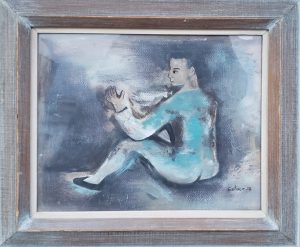(Click to Enlarge)
Oil on Textured Artist Board
12 x 14 3/4 inches
17 3/4 x 20 1/4 inches framed behind glass in mid century frame
Fine condition
Signed Sebree .38 lower right
Chicagoland origin
Charles Sebree
b. 1914, Madisonville, KY – d. 1985, Washington, DC
Biographical sources differ slightly on the location of Charles Sebree’s birth—either Madisonville or nearby White City, in western Kentucky. (A town called Sebree, about fifteen miles north of Madisonville, was founded by the former Union army officer and industrialist Col. E. G. Sebree in 1868, but his connection with Charles Sebree is unknown). An only child, Sebree came to Chicago with his mother at the age of 10 in 1924. Regarded as a prodigy by his art teacher at Burke elementary school at 53rd and Grand Boulevard, Sebree’s artwork was brought to the attention of the Renaissance Society at the nearby University of Chicago, one of the few outlets for the exhibition of modern art in Chicago. Sebree’s early success in Chicago modern art circles was viewed with suspicion by more established black artists in Chicago. William McKnight Farrow, a founder of the black artists organization, the Chicago Art League, met Sebree at the 1934 Grant Park outdoor art fair and reported that his work “caused considerable controversy among the artists there as well as among the visitors. . . . He possesses a peculiar talent for producing work of an emotional quality, and strange as it seemed to those of academic training, he sold everything he took there for display.” Sebree was known for being personally quite mercurial. The 1930s Chicago gallerist and later first curator of modern art at the Art Institute of Chicago, Katharine Kuh recalled that Sebree, “regularly stole hundreds of postage stamps from the gallery and then resold them. When I confronted him with the problem, he said it would be ‘dishonest’ for him to pretend that his behavior might change. ‘After all,’ he reminded me, ‘we are good friends.’ And believe it or not, he continued to steal, though of course, honestly, and I continued to show his work.”
Along with fellow Englewood High School students Margaret (Taylor) Burroughs, Eldzier Cortor, and Charles White, Sebree took Saturday art classes at the School of the Art Institute of Chicago (SAIC). Sebree was welcomed into the bohemian atmosphere of the salon/studio of dancer and University of Chicago anthropology student Katherine Dunham, where black and white artists and intellectuals mixed. Sebree danced and designed sets and costumes for Ms. Dunham’s lavish dance productions. After graduation from high school, Sebree was employed by the easel division of the WPA’s Illinois Art Project. Sebree was drafted in 1942 and stationed at Camp Robert Smalls, a segregated enclave within the larger Great Lakes Naval Training base, north of Chicago. Here he met playwright Owen Dodson, who would become his lifelong friend. The two produced several plays together at Camp Smalls, including the “Ballad of Dorrie Miller,” dedicated to a black naval mess attendant who saved the lives of several shipmates at Pearl Harbor. Sebree moved to New York after the War, where he pursued both visual art and theatrical projects. He received a Julius Rosenwald Fund fellowship in 1945, and went on to co-write the successful 1954 Broadway musical, Mrs. Patterson, starring Eartha Kitt. Sebree moved to Washington, D. C. in the 1950s.
Untitled (Toy Boats), which shows the boys’ isolation and tentativeness, may be a reflection of the Miller story, in which the aspirations and participation of blacks in American life—in an era when segregation was legal and widespread—were curtailed. Sebree’s palid blue-green and ochre color scheme and black outline, curvilinear and heavy, also suggests a debt to the school of Paris of the 1920s, in particular, the work of Picasso and Rouault. The standing figure’s expression of strange diffidence, so common in Sebree’s work also may allude to Sebree’s homosexuality, which was both overt (in his bohemian artistic circles), yet hidden from the larger public.
Daniel Schulman
References
Farrow, William McKnight, to Evelyn S. Brown. April 15, 1935. Harmon Foundation Papers. Manuscript Division, Library of Congress.
Kuh, Katharine. My Love Affair with Modern Art: Behind the Scenes with a Legendary Curator, edited and completed by Avis Berman, 5. New York: Arcade Publishing, 2006.
Motley, Willard. “Negro Art in Chicago.” Opportunity 18, no. 1 (January 1940), 29.
source: www.chicagomodern.org




